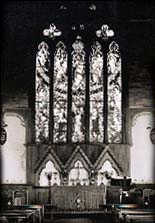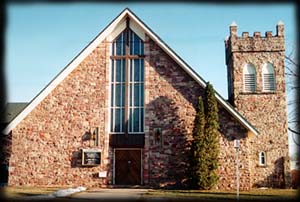|

|
In 1870 Bishop
Bethune laid the cornerstone for the first stone
church in Sault Ste. Marie, called St. Luke's. It
was Sault Ste. Marie's first Anglican Church. Prior
to its construction, James Chance had been serving
as a missionary to the Garden River Reserve,
ministering to congregation by canoe and sailboat
in summer and snowshoes in winter. In 1854 he began
a fund-raising campaign to build a permanent church
in Sault Ste. Marie and, in 1859, the Crown deeded
property to the Bishop of Toronto for this express
purpose.
Chance was a
relentless fund-raiser. He even managed to get the
British Army, under the command of Colonel Garnet
and Major Rounthwaite, to give generously towards
construction costs when they passed through on
their way to the North-west Rebellion in 1869. They
later served as honour guards when it was time to
lay the cornerstone. Within ten years, the small
church was enlarged to accommodate the growing
congregation. Transepts to the north and south were
added as well as a chancel to the east and a belfry
at the west. These modifications moved the entrance
from Brock Street to Albert Street. In 1896, it was
consecrated as a Pro-Cathedral.

In 1902, St. Luke's
suffered the first of two fires, the second
occurring only one year later. Neither were very
serious, unlike the third which happened in 1952.
Plans had been discussed for years to build a new
and larger cathedral, though not much progress was
made. After the third fire, the congregation threw
all their efforts into rebuilding St. Luke's,
including raising $64,000 during a twelve-hour
vigil on Sunday, December 21, 1952. C.F.T.
Rounthwaite, grandson of Major Rounthwaite, was
hired as architect of the new cathedral and he set
about incorporating what was left of the historic
wall, the south transept, the intervening south
wall and the bell tower into his design.
St. Luke's
Cathedral is constructed of local, red-streaked
sandstone. One and one half tons of laminated
trusses, used in the reconstruction in the 1950's,
are exposed within the structure.
|
The cathedral's most impressive feature is
a 25-foot stained-glass window behind the
altar, created by Angus MacDonald.
Constructed of glass accumulated from
several countries, the window is one of
the most impressive works in modern
stained glass to have been commissioned in
Canada. St. Lukes was also supposed to
receive two other valuable stained-glass
windows. Dating from the time of Oliver
Cromwell, they had been rescued from
London churches destroyed during the
Blitz, in World War II.
|

|
Removed and
carefully wrapped, these were among many such
windows congregants in England buried underground
to protect and preserve them from enemy fire. Those
that could not be replaced in their church of
origin were sent to North American churches. The
two intended for St. Luke's could not be placed and
in turn were installed in St. John's and St.
Peter's Churches, also in Sault Ste. Marie.
There are many
other items of beauty and historical significance
in St. Luke's Cathedral, including the memorial
windows in the east wall. Plaques recognizing
Charles Vernon Plummer, William H. Plummer, Sir
James Dunn and other prominent local people also
line the walls. 1995 marked the 125th anniversary
of St. Luke's. The year-long celebration began with
the firing of the same cannon that used to signal
the arrival and departure of the missionary ship
The Evangeline. Bishop Sullivan, the Bishop of
Algoma, used this ship in the late 1800s to carry
out his duties along the shores of Lakes Superior
and Huron.
|

|
The story
of St. Luke's Cathedral is one firmly
grounded in history, yet a tiny'
representation soared into the heavens
aboard a United States space shuttle, in
1992. Dr. Roberta Bondar carried aboard
the Discovery a St. Luke's cloth crest for
Dean Robertson. The Diocese of Algoma
cloth crest was representative of the
parish of the Bondar family.
|


|
![]()